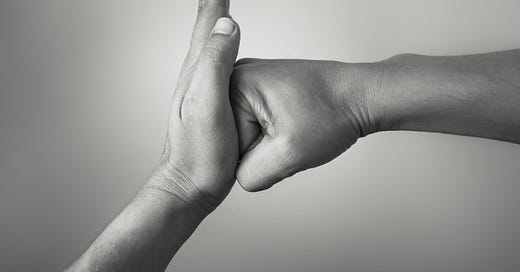Welcome
For this post, I want to talk about an issue that is frequently discussed and often very misunderstood: domestic abuse survivors who fight back against their abusers.
Fighting back against what?
In order to understand survivors who fight back, we first need to realise what survivors are up against.
Not all violent behaviour in relationships is the same. Broadly speaking, there is a distinction between what researcher Michael P. Johnson calls (1) ‘situational couple violence’ and (2) ‘intimate terrorism/coercive control’.
(1) ‘Situational couple violence’ is violence that occurs during couple conflicts, when a conflict escalates into verbal aggression and acts of physical violence, but where the aggressor is not aiming to control their partner’s life or restrict their liberty.
(2) ‘Intimate terrorism/coercive control’ tends to be much more severe. Intimate terrorism/coercive control involves an abusive person who is highly driven and motivated to dominate, control and exploit their ‘partner’. (I’m putting ‘partner’ in quote marks here because what is happening here is not a partnership. Rather, it is an abuser who is posing as a ‘partner’ and pretending to be in a ‘relationship’ in order to abuse. Thank you to Dr Andrew Cicchetti’s Twitter account for pointing out how the language of ‘partner’ and ‘relationship’ is problematic in cases of intimate terrorism/coercive control.)
Intimate terrorists/coercive controllers want to strip their ‘partner’ of all their human rights, and to scare, coerce and manipulate their ‘partner’ into giving up everything that they care about. The intimate terrorist/coercive controller wants their ‘partner’s’ life to become totally dedicated to pleasing and serving them, and for their ‘partner’ to have no plans, goals, needs or wishes of their own.
To achieve this highly abusive goal, intimate terrorists/coercive controllers use multiple tactics of abuse, and they use these tactics all the time: psychological abuse, economic abuse, isolation, monitoring and stalking, threats and intimidation. Some (though not all) intimate terrorists/coercive controllers also carry out physical and sexual violence in order to scare, dominate, control and exploit their ‘partner’.
The abused ‘partner’ is increasingly entrapped over time in the abuser’s world of control.
Before anyone forms any opinions on a case where there has been an accusation of domestic abuse/IPV, they should try to find whether it is a case of (1) or (2). For example, does one ‘partner’ show an attitude of over-entitlement and possessiveness? Do they think that they have the right to dictate how their ‘partner’ dresses? Does the other ‘partner’ have to over-explain and beg for permission to do ordinary things, like take up an employment opportunity, or even to simply leave the house? These are all signs of (2) intimate terrorism/coercive control.
Public misunderstandings of fighting back
The general public isn’t yet particularly aware of the distinction between (1) ‘situational couple violence’ and (2) ‘Intimate terrorism/coercive control’. Indeed, the public is still largely unaware of what (2) involves and just how severe and harmful (2) is.
So when the public hears of a case of domestic abuse/IPV, they often tend to assume it is a case of (1) situational couple violence. Let’s take a fictional example of a relationship where there has been violence, between Jack and Claire. The public’s thinking tends to go something like this: Jack hit Claire. That’s bad. But Claire hit Jack back, so she must also be bad. This has happened a few times, and Claire hasn’t left, so she must be enjoying the drama. If it was really bad she would leave. They are both toxic. It’s ‘six of one and half a dozen of the other’. It’s mutual abuse, as they are both hitting each other.
THIS WAY OF THINKING IS FUNDAMENTALLY WRONG.
It’s often not just our neighbours, communities and persons on social media expressing these faulty ways of thinking. It may also be the police officers, social workers, judges and other professionals whose jobs bring them into regular contact with abusers and survivors. This is highly problematic and can lead to disastrous outcomes.
Fighting back against situational couple violence
Let’s return now to how the public might misunderstand what is happening between our fictional couple Jack and Claire. Let’s firstly imagine that what happened between Jack and Claire is (1) ‘situational couple violence’. If this were a case of situational couple violence, then the public would be wrong to assume that Jack and Claire are ‘both as bad as each other’. Physical size, strength, and experience with fighting makes a difference here. Research has found that women are more likely to be hurt than men when situational couple violence takes place. Furthermore, hitting back against someone who has been violent towards you does not make you ‘just as bad’.
Also, there may be many reasons why a person who is experiencing situational couple violence may not be ending their relationship. Research shows that women are more likely to be wholly or partly financially dependent on a partner than men are, so Claire may be staying because she cannot afford to leave. Claire may hope that Jack can get help and support so that he can learn to stay calm during their conflicts. If the violence that takes place when Jack and Claire are in conflict is less severe, infrequent, and not injurious, then Claire may feel that the good things about the relationship outweigh the bad things overall. One thing we can be fairly certain of is that Claire is not ‘enjoying the drama’ of this violence. The idea that women find violent arguments enjoyable is a sexist myth.
Fighting back against intimate terrorism and coercive control
Now let’s imagine that what happened between Jack and Claire is (2) ‘intimate terrorism/coercive control’. Now, the public’s misunderstanding of Claire’s fighting back would be even more wrong. If Jack is subjecting Claire to a regime of ongoing coercive control and intimate terrorism, then his violence will be just one of many tactics he is using to try to scare her into submission. He will be placing her under constant pressure to give up everything she cares about. She will be living in a highly constrained way, unable to exercise her human rights. Claire’s freedom, liberty and autonomy will be almost non-existent.
Claire will be facing multiple barriers to leaving. Jack may have drained her of her money and assets; isolated her; and manipulated her empathy and goodness to make her think that she has to stay in order to take care of him. He has perhaps claimed that he will die or become seriously ill without her, or that he won’t be able to cope without her. He may have told her that: ‘If I can’t have you, no one else can’ - which is essentially a death threat. He may have told her that if she seeks help, no one will believe her: that he has friends on the police force; that he will have her sent to a mental institution, that he will make sure that she never sees their children again. These are just some examples. The barriers to leaving a coercive controller are so numerous that they could be the subject of a whole blog in their own right.
If Jack hits Claire in these circumstances and Claire hits back, then this should be seen in the same way as kidnapped person using violence against someone who has abducted them and is holding them hostage. Fighting back, physically or verbally, might be a way for Claire to express that she hates the way Jack is abusing her and the way he denies her human rights. It is important for Claire to be able to express her hatred of the situation in any way she can, because Jack will be pretending the situation is perfectly normal and that Claire is ‘making a fuss about nothing’. This is crazy-making behaviour from Jack. Resisting by fighting back may therefore be helpful to Claire’s besieged psychological health and sense of sanity. Fighting back might be a way of Claire desperately trying to assert herself and her rights in a situation where her selfhood is being crushed and her rights taken away from her. Fighting back may be a way for Claire to defend herself against severe violence and possible murder (for example by scratching at Jack’s arms as he strangles her). Claire fighting back may even possibly lessen the severity or frequency of Jack’s violence towards her. (A minority of abusers may be less willing to physically attack if they know the survivor is going to fight back.)
In the midst of Jack’s ongoing coercive control, Claire might be the one to become violent first. She may know from long experience that Jack is building up to attacking her. She knows that this will happen soon. The tension is unbearable, so she gets violent first to end the tension and to get the inevitable violence Jack is going to subject her to over with. On the other hand, Claire might be finding Jack’s cruel psychological abuse or monitoring and isolation of her unbearable, and might violently lash out at him in a moment of despair and distress, perhaps throwing an object at him. This is out-of-character behaviour for Claire, but being abused by an intimate terrorist unsurprisingly makes people behave in out-of-character ways!
Not all survivors fight back. It depends on the context. It also depends on the way that the survivor instinctively responds to danger and trauma. There are five common responses to trauma: ‘fight’, ‘flight’, ‘freeze’, ‘flop’, or ‘fawn’. The first three are fairly self-explanatory. ‘Flop’ involves passing out or collapsing when in danger or distress. ‘Fawn’ involves trying to appeal to the source of danger in the hopes that they won’t hurt you. How a person responds to danger in a traumatic situation is involuntary and is not within the survivor’s control. Fighting back or not fighting back is not issue of morality. It doesn’t say anything about the survivor’s worthiness or their general character.
How a survivor fighting back against coercive control should be treated
A survivor fighting back should be treated with great compassion, understanding and leniency. They should be offered the supports they wish for, rather than being judged harshly or punished. It is vital to remember that the survivor would have nothing to fight back against if the abuser stopped abusing them. It is the abuser who is making the choice, every day, every hour, to keep their regime of coercive control and intimate terrorism going against the survivor. The abuser is the one with the power in the situation. The survivor is trying to survive in a situation that they never wanted to be in; a situation in which the abuser has them entrapped.
Goodbye for now
Let me leave you with a picture of my dogs Coco (the tiny one) and Sophie that I took a couple of days ago.
I hope this blog on domestic abuse survivors who fight back has been useful to you. Please feel free to share it far and wide, because it is vital that we develop better understandings of this aspect of domestic abuse/IPV.






Well done and thank you Emma. You capture the essence of CC so well, and write with integrity and compassion. A heartfelt thank you from me.
This is a very helpful description of the difference between situational violence and coercive control. Thank you.